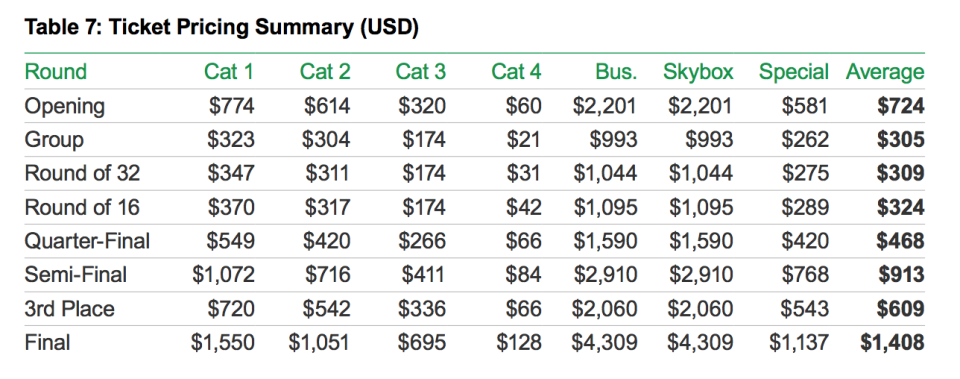The 2026 World Cup is coming to North America. Here's what you need to know
After years and years of planning and campaigning, U.S. Soccer finally got what it desired on Wednesday: Another men’s World Cup on home soil.
FIFA’s 200-plus members awarded the 2026 edition of the world’s greatest sporting event to North America, meaning the World Cup is coming to the U.S., Mexico and Canada in eight years time.
So what does that mean? What will the experience be like? What do you need to know about the continent-wide party that can’t get here soon enough?
Host cities
The most important aspect of the plan is that 60 of the 80 games – 80, because the World Cup is expanding to 48 teams in 2026 – will be played in the United States. Canada and Mexico will get 10 games apiece.
Three Canadian and three Mexican cities will definitely stage games: Edmonton, Montreal and Toronto to the north; and Guadalajara, Mexico City and Monterrey to the south.
The bid committee, however, submitted 17 possible U.S. host cities to FIFA – seven more than necessary. So no American city is assured of games. But some are all but assured.
The 17 cities and stadiums in contention, roughly in order of likelihood they make the final list, are: New York (MetLife Stadium, East Rutherford, N.J.), Los Angeles (Rose Bowl, Pasadena), Atlanta (Mercedes-Benz Stadium), Dallas (AT&T Stadium, Arlington), Washington D.C. (FedEx Field), San Francisco Bay Area (Levi’s Stadium, Santa Clara), Boston (Gillette Stadium, Foxborough), Philadelphia (Lincoln Financial Field), Miami (Hard Rock Stadium), Houston (NRG Stadium), Seattle (CenturyLink Field), Denver (Mile High Stadium), Nashville (Nissan Stadium), Orlando (Camping World Stadium), Kansas City (Arrowhead Stadium), Baltimore (M&T Bank Stadium) and Cincinnati (Paul Brown Stadium).
[Which potential U.S. host cities will make the cut? Our 1-17 ranking]
The list will be cut from 17 down to 10 by 2021. Cities will barter with the bid committee and compete with each other. They’ll likely be selected not solely based on traditional criteria, but on how much they promise to invest in soccer outside of the World Cup. The ultimate decision is FIFA’s, but the North American organizing committee will certainly have a say in the matter.
Some big cities – Chicago and Vancouver, among others – pulled out of the running earlier this year, citing unknowns in host city agreements and taxpayer risk.
Will all three co-hosts qualify automatically?
Yes, presumably. That’s not official, but it’s expected. FIFA president Gianni Infantino said Wednesday that the decision is CONCACAF’s. U.S. Soccer president Carlos Cordeiro later said, “that is not CONCACAF’s decision, that is FIFA’s decision.” So it’s unclear how exactly that decision will be made.
But no matter who makes it, the decision will surely be to award auto bids to the Canada, Mexico and the United States. The bid book even assumes that to be the case.
Which games will be held when, and where?
The United Bid proposal calls for each of the three host nations to play on the tournament’s opening day, likely in early- or mid-June. The “main” opener will either be at Estadio Azteca in Mexico City or the Rose Bowl in Southern California. Canada’s opener would presumably either be in Toronto or Montreal.
The official bid book submitted to FIFA also specifies Atlanta and Dallas as the bid committee’s preferred semifinal hosts, and MetLife Stadium in northern New Jersey as the likely site of the final. Other semifinal candidates are Boston (Foxborough) and Washington D.C. (Landover, Md.).
In general, the bid committee promised a “balance of matches” between cities, and said the knockout round games would flow from the west in early rounds to the east in later rounds, in order to minimize travel. Every U.S. city would get at least two knockout round games.
The bid committee even drew up a mock schedule, which is below. As you can see, New York is “US1,” Los Angeles is “US2,” and so on.

Based on that mock-up, every U.S. city selected would host at least five games, and at most seven. Every Canadian and Mexican city would get at least three.
Infantino pointed out Wednesday that none of these plans are final. That includes the 60-10-10 split between nations. But there is no reason to think there will be major changes between now and 2026.
Other festivities, hundreds of thousands of visitors
The three countries, and especially the U.S., will truly be transformed for a month. It will be a nation(s)wide party unlike any the world has never seen before. Thousands of visitors from all around the globe – from 45 participating nations, and elsewhere – will descend on North America.
Even cities that aren’t awarded matches will light up during the tournament. There will be fan zones and other special events. FIFA currently organizes “fan fests” in every host city. The United Bid proposed “pop-up fan fests” in non-host cities.
And teams will likely make use of cities not on the list of potential hosts – Chicago, for example – for base camps. So the World Cup will touch almost every major city in the United States.
Insane ticket prices
The main drawback for fans already getting excited about 2026, and looking forward to hopefully attending matches? Ticket prices.
The United Bid projected $2.1 billion in ticket revenue on 5.8 million tickets sold. That would make the average ticket price $362, which is exorbitant. The bid book provided a breakdown:

So cheap tickets will be available, especially in the group stage and early knockout rounds. But not many, and only in the upper decks of stadiums. Anything better will cost a lot.
Importance of 2026 World Cup to soccer in America
The United Bid has promised roughly $11 billion in profit. But that’s FIFA’s profit. Much of it filters down to FIFA’s 200-plus member associations – roughly $50 million per nation. That, obviously, is already significant.
But the 2026 World Cup will be profitable for U.S. Soccer in other ways. It’ll provide an unquantifiable boost to soccer in the United States and Canada. Fan interest will undoubtedly ramp up to all-time highs during the tournament, and will leave a lasting impression, with many converts sticking around.
[Schaerlaeckens: 2026 World Cup will launch third era of American soccer]
And the mere prospect of the tournament will stimulate investment in the game at all levels. As Sunil Gulati, the former chairman of the United Bid, told Yahoo Sports earlier this month, competition among potential host cities for those 10 coveted U.S. spots will force many to commit money to soccer development initiatives.
“We want to be able to talk to cities and say, ‘Hey, you don’t have to build anything here, but let’s have an after-school program,’” Gulati said. “It’s building a soccer infrastructure, not a building infrastructure.”
So the 2026 World Cup will be invaluable. The importance, as discussed here, really can’t be understated.
What’s next on U.S. Soccer’s agenda?
A lot. Because recently-elected U.S. Soccer president Carlos Cordeiro, one of the three United Bid co-chairs, has dedicated the vast majority of his first four months in office to obtaining the 2026 World Cup. Now that he has secured it, he can rest up a bit, then get to work on other initiatives. He can begin to enact the reform he has promised.
But he may soon have another bid to launch. Part of Cordeiro’s platform during the USSF presidential campaign was a pledge to try to bring the 2027 women’s World Cup to the United States as well. It would be the third of its kind in the U.S. on the women’s side. And with the 2019 tournament in Europe (France) and Asian nations favored for the 2023 edition, the U.S. would seemingly be in the driver’s seat for 2027.
And hosting back-to-back World Cups, of course, would provide an unprecedented boost to soccer in the U.S.
But with the 2023 decision still relatively far in the distance, and 2027 further, Cordeiro and U.S. Soccer have some time to reset before pouring time, energy and money into another bid.
– – – – – – –
Henry Bushnell covers global soccer for Yahoo Sports. Have a tip? Question? Comment? Email him at henrydbushnell@gmail.com, or follow him on Twitter @HenryBushnell, and on Facebook.
More coverage from Yahoo Sports:
• U.S., Canada, Mexico win right to co-host 2026 World Cup
• Schaerlaeckens: Successful bid marks start of U.S. Soccer 3.0
• Ranking potential U.S. host cities, from most to least likely
• 2018 World Cup preview hub



